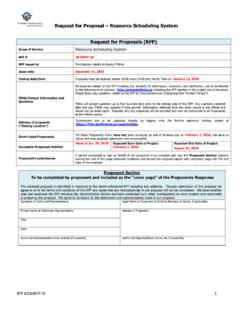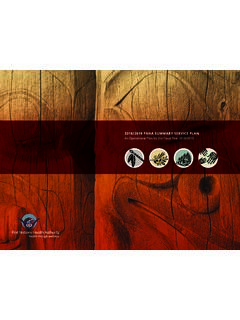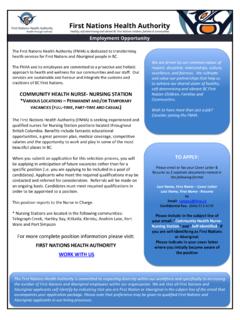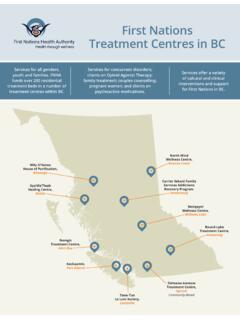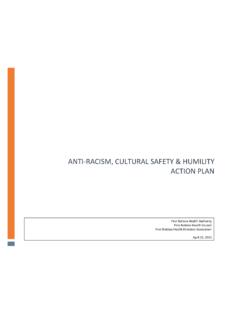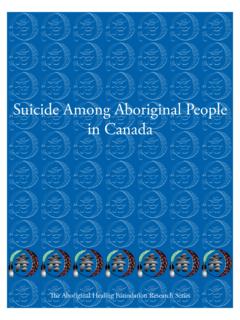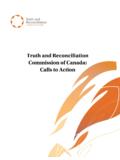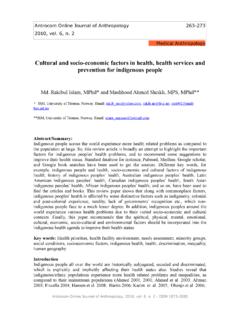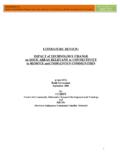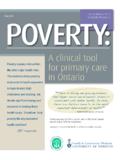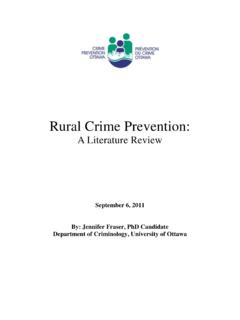Transcription of A Planning Toolkit for First Nations and Aboriginal ...
1 Hope, Help, and HealingA Planning Toolkit for First Nations and Aboriginal communities to prevent and Respond to SuicideIn Partnership WithHope, Help, and Healing: A Planning Toolkit for First Nations and Aboriginal communities to prevent and Respond to suicide 2015. Copyright for this publication is held by the First Nations Health Authority. This publication may be reproduced without permission provided the source is fully partnership with: First Nations Health Authority501 - 100 Park Royal SouthCoast Salish TerritoryWest Vancouver, BCCanada - V7T | Vision: Healthy, Self-Determining and Vibrant BC First Nations Children, Families and communities . HOPEHELPHEALINGHOPE, HELP, AND HEALINGI ntroduction 1 Acknowledgments 1 The Path to the Hope, Help and Healing Toolkit 3 About the Approach 5 About the Toolkit 7 Developing Your PIP Plan - The Planning Roadmap 9 Section 1.
2 Preparing for the Planning Journey 11 First Nations Perspective on Wellness 13 What is your role as the Community Worker / Coordinator? 18 Tips for Looking after yourself during the journey 19 Tool : Comprehensive Self-Care Reminders 20 Section 2: Learning 21 Setting the Context 23 The Determinants of First Nations / Aboriginal Health 24 Risk and Protective Factors Related to suicide 26 Promising Practices for HOPE (Prevention) 36 Promising Practices for HELP (Intervention)
3 41 Creating a Safety Plan 47 Promising Practices for HEALING (Postvention) 49 Section 3: Gathering 55 Preparing to plan 57 suicide PIP Plan Template Sample 59 Tool : Template to Set Up Your Coordinating Committee 62 Tool : Draft Agenda for First Coordinating Committee Meeting 64 Tool : Draft Terms of Reference for the Coordinating Committee 65 Tool : Sample Confidentiality Agreement 67 Tool : Draft Budget Template for Coordinating Committee 69 Tool : Example Letter to Chief and Council, Health Board or Health Council 71 Tool : Community Readiness Assessment Example 73 Tool : Community Information Gathering Template 75 Tool : Identifying Strengths and Gaps in Your Community 76 HOPE, HELP, AND HEALINGT able of ContentsHOPEHELPHEALINGFIRST Nations HEALTH AUTHORITY Tool : Hope/Prevention - Building Community Resiliency 76 Tool : Help/Intervention - Being Ready to Respond in a Crisis 78 Tool.
4 Healing/Postvention - Critical Response and Supporting People After a Loss 80 Tool : Analysis of Information 82 Tool : Prioritize Your Issues and Needs Template 83 Tool : Sample Workplan (Who does what) 84 Section 4: Sharing 85 Preparing for Community Engagement 86 Facilitator Role at the Community Engagement Sessions 89 Writing and Completing your Plan 93 Community-based Volunteer suicide Response Teams 95 Community suicide Crisis Response Coordination Template 106 Tool : Workplan Tasks for Action (Example from PIP Plan) 114 Tool.
5 Monitoring and Reporting on the PIP Plan Implementation 117 Best Practices - Prevention, Intervention, Postvention Programs 118 Evaluation Guidelines and Examples 127 Expanding Beyond Evaluation to Surveillance as a Community 130 Tools to Support Recognition of suicide Risk 133 Tools to Support Organizational Responses to Suicidal Behaviours 136 Tools to Support Responses After a suicide 137 Tools to Support Responses to suicide Clusters 141 Conclusion 143 suicide Quick Reference Guide 144 Glossary
6 147 APPENDICES 152 Appendix 1: Important Contacts and Resources 152 Appendix 2: Health Research and suicide 171 Appendix 3: Planning Tools and Templates 173 Appendix 4: Tripartite suicide Prevention, Intervention and Postvention Working Group Members 187 HOPEHELPHEALING1 | HOPE, HELP, AND HEALINGT hanks and acknowledgment to everyone who participated in the development of this Toolkit , in particular:The partner First Nations communities who tested the Toolkit and provided valuable feedback and input to enable completion: Cowichan Tribes at Duncan in the Vancouver Island Region; Three Corners Health Society at Williams Lake in the Interior Region; Skidegate Health Centre at Haida Gwaii in the Northern Region; Southern Stl atl imx at Pemberton in the Vancouver Coastal Region; and Sts Ailes First Nation near Mission in the Fraser Salish Region.
7 Members of the Tripartite Working Group for suicide Prevention, Intervention, Post-vention: First Nations Health Authority Fraser Health BC Ministry of Health Interior Health BC Ministry of Children and Family Development Northern Health BC Ministry of Aboriginal Relations and Reconciliation Island Health Provincial Health Services Authority Vancouver Coastal HealthINTRODUCTION AND WELCOMEA cknowledgementsEmergency Resources 1-800-SUICIDEIf you are in distress or are worried about someone in distress who may hurt themselves, call1-800- suicide (1-800-784-2433) 24 hours a day to connect to a BC crisis line, without a wait orbusy signal. KUU-US Crisis Line SocietyFirst Nations and Aboriginal specific 24/7 crisis line based in Port Alberni and serving the entireprovince. Toll-free: 1-800-588-8717 - Youth Line: 250-723-2040 - Adult Line: 250-723-4050. Native Youth Crisis Hotline - 1-877-209-1266 Answered by staff 24/7.
8 Available throughout Canada and US. Youth in BCVisit for youth resources or chat with a counselor can also call 1-866-661-3311 (toll-free in BC) 24 hours a day. 310-6789 (no area code needed) Mental Health Information LineAnswered 24/7/365 it provides empowering emotional support, information on appropriatereferral options and a wide range of support relating to mental health the Here to Help website for more information: Nations HEALTH AUTHORITY | 2 INTRODUCTION AND WELCOMEC elebrating WellnessThe artwork and drawings in this document were developed by First Nations youth in BC to express their concepts of wellness. They were initially developed for the First Nations Educa-tion Steering Committee Seventh Generation Club Art Contest and were kindly shared for the use of this document. We raise our hands to the Youth artists for sharing their wellness Elementary SchoolHOPEHELPHEALING3 | HOPE, HELP, AND HEALING Tripartite Partners Shared Vision - from the 2012 Health Partnership Accord Our shared vision is a future where BC First Nations people and communities are among the healthiest in the world.
9 We envision healthy and vibrant BC First Nations children, families, and communities playing an active role in decision-making regarding their personal and collective wellness. We see healthy First Nations people living in healthy communities , drawing upon the richness of their traditions of health and wellbeing. In this vision, First Nations people and communities have access to high quality health services that are responsive to their needs, and address their realities. These services are part of a broader wellness system a system that does not treat illness in isolation. These services are delivered in a manner that respects the diversity, cultures, languages, and contributions of BC First Nations . The Transformative Change Accord: First Nations Heath Plan (2006) outlines a health action to: Improve collaboration and partnership between agencies, organizations, authorities, and governments with First Nations and Aboriginal people to prevent and respond in a timely manner to young adult suicide through a range of supports and services.
10 A Path Forward: BC First Nations and Aboriginal People s 10 Year Mental Wellness and Substance Use Plan (2013). Within A Path Forward , Strategic Direction H relates directly to suicide response and prevention: Strategic Direction H: First Nations and Aboriginal communities have the capacity to support and deliver mental health promotion, suicide prevention, intervention, and postvention initiatives that build resiliency and promote THE TOOLKITThe Path to the Hope, Help, and Healing ToolkitTyresse Sts'ailes Community SchoolHOPEHELPHEALINGFIRST Nations HEALTH AUTHORITY | 4 The Tripartite Working Group on suicide Prevention, Intervention, Postvention (PIP) was contacted by a Health Director who was grappling with a number of recent suicides in their community. The Health Director was aware of supports available to draw on for immediate support and stabilization but identified a lack of resources in the areas of suicide prevention and postvention - or as the Health Director asked, what supports are available to stop this from happening again?

